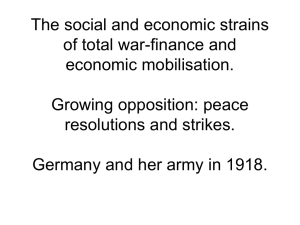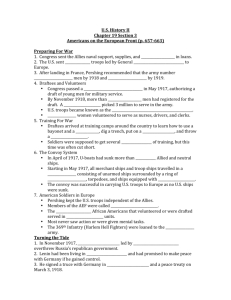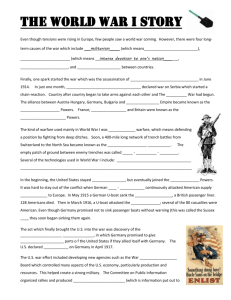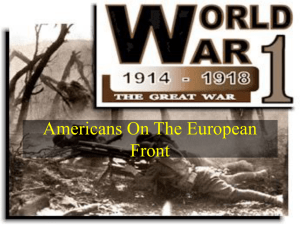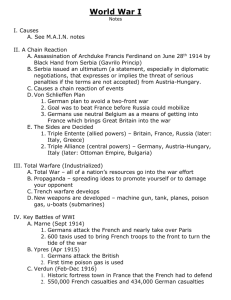Background The beginning of change, 1917
advertisement
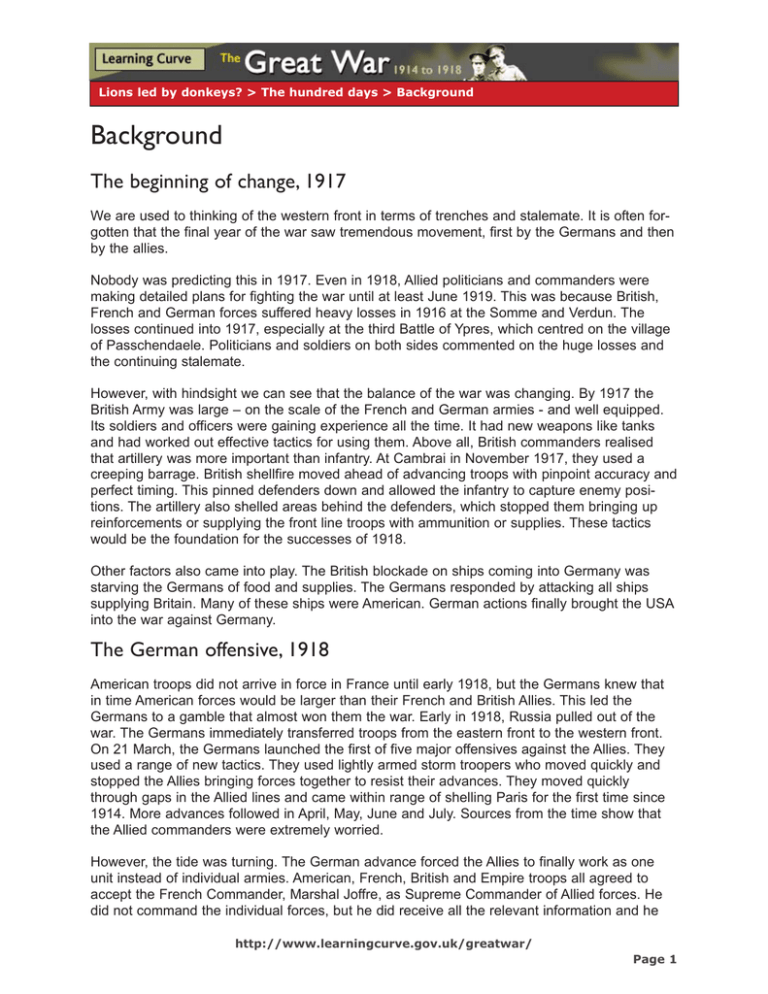
Lions led by donkeys? > The hundred days > Background Background The beginning of change, 1917 We are used to thinking of the western front in terms of trenches and stalemate. It is often forgotten that the final year of the war saw tremendous movement, first by the Germans and then by the allies. Nobody was predicting this in 1917. Even in 1918, Allied politicians and commanders were making detailed plans for fighting the war until at least June 1919. This was because British, French and German forces suffered heavy losses in 1916 at the Somme and Verdun. The losses continued into 1917, especially at the third Battle of Ypres, which centred on the village of Passchendaele. Politicians and soldiers on both sides commented on the huge losses and the continuing stalemate. However, with hindsight we can see that the balance of the war was changing. By 1917 the British Army was large – on the scale of the French and German armies - and well equipped. Its soldiers and officers were gaining experience all the time. It had new weapons like tanks and had worked out effective tactics for using them. Above all, British commanders realised that artillery was more important than infantry. At Cambrai in November 1917, they used a creeping barrage. British shellfire moved ahead of advancing troops with pinpoint accuracy and perfect timing. This pinned defenders down and allowed the infantry to capture enemy positions. The artillery also shelled areas behind the defenders, which stopped them bringing up reinforcements or supplying the front line troops with ammunition or supplies. These tactics would be the foundation for the successes of 1918. Other factors also came into play. The British blockade on ships coming into Germany was starving the Germans of food and supplies. The Germans responded by attacking all ships supplying Britain. Many of these ships were American. German actions finally brought the USA into the war against Germany. The German offensive, 1918 American troops did not arrive in force in France until early 1918, but the Germans knew that in time American forces would be larger than their French and British Allies. This led the Germans to a gamble that almost won them the war. Early in 1918, Russia pulled out of the war. The Germans immediately transferred troops from the eastern front to the western front. On 21 March, the Germans launched the first of five major offensives against the Allies. They used a range of new tactics. They used lightly armed storm troopers who moved quickly and stopped the Allies bringing forces together to resist their advances. They moved quickly through gaps in the Allied lines and came within range of shelling Paris for the first time since 1914. More advances followed in April, May, June and July. Sources from the time show that the Allied commanders were extremely worried. However, the tide was turning. The German advance forced the Allies to finally work as one unit instead of individual armies. American, French, British and Empire troops all agreed to accept the French Commander, Marshal Joffre, as Supreme Commander of Allied forces. He did not command the individual forces, but he did receive all the relevant information and he http://www.learningcurve.gov.uk/greatwar/ Page 1 Lions led by donkeys? > The hundred days > Background came up with military plans that made the most effective, co-ordinated use of all the of resources of the Allies. At the same time as the Allies began to co-ordinate effectively, German forces began to run out of manpower, resources, ammunition and equipment. The hundred days On 18 July, the Allies counter-attacked and began to push the Germans back. On 8 August, Sir Douglas Haig began a British and Empire attack at Amiens. He quickly drove the Germans back to the Hindenburg line. The Hindenburg line was the German army's line of well-defended trench systems established in 1917. The German commander, Ludendorff, called it a black day for the German Army. In fact the Allies were just as surprised as the Germans by their advances. From 27 September to 17 October, British and Empire forces stormed the Hindenburg line. The German army went into a slow collapse. There were mutinies among reserve troops. The German high command asked for an armistice on 3 October. The armistice was agreed on 11 November and the fighting stopped. It never restarted. There is no doubt that the naval blockade had weakened Germany and its armed forces by 1918. There is also little doubt that American forces played a big part in making the Germans surrender. By late 1918, they already had 2 million men in France and they were ready to send as many more troops as were needed to defeat Germany. However, the major victories of the last hundred days of the war were mainly won by Haig and the British Army. As Professor Peter Simpkin has said: "If we are prepared to criticise Haig and his army commanders for their mistakes in 1916 and 1917, then it is perhaps only fair that, at the same time, they should receive due credit for their decisive, but forgotten victories in 1918." So how did this change in fortune happen? Back in Britain, both government and industry were much better organised. They were finally producing enough rifles, machine guns, grenades, artillery pieces and so on for the war effort. Production of heavy guns in 1918 was 10,682 compared to 3,226 in 1915. The artillery shells were reliable and there was a plentiful supply. British artillery gunners now had far more shells to fire than the German opponents. By the time Haig attacked in August 1918, warfare had come a long way. Tanks had certainly improved, but better artillery was the key. British artillery was now extremely accurate. They had perfected the creeping barrage used so effectively in Cambrai in 1917. The artillery also used microphones to pinpoint the location of enemy guns and destroy them. They could do this without having to fire 'warm-up' shots to get the range right. These advances meant that there was virtually no gap between the end of the bombardment and the start of the attack. This in turn meant the Germans did not get an advance warning of an attack – and the enemy's guns were also out of action. Aircraft helped Haig's guns to spot their targets. US, French and British aircraft greatly outnumbered German planes, which gave them freedom of the skies. During rapid advances, aircraft delivered messages, ammunition and other supplies to advancing troops. Using radio, they could keep Haig and other commanders in touch with what was happening on the battlefield. Aircraft also played an import role in disrupting German communications. They bombed communication trenches and slowed up reinforcements by machine-gunning them from the air. http://www.learningcurve.gov.uk/greatwar/ Page 2 Lions led by donkeys? > The hundred days > Background Haig had learnt that firepower was now more important than manpower. An average battalion at the Somme numbered about 1000 men with four machine guns and two mortars. In August 1918, Haig had battalions of about 500 men, but they had thirty machine guns, eight mortars and six tanks. There were also individual brainwaves, such as when British and Canadian troops captured the St Quentin Canal. Artillery shelled the defences and fired smoke bombs. The troops then crossed the canal using life jackets and rafts borrowed from the cross-channel ferries that were used to ferry troops across the Channel! The series of victories that drove the Germans back in 1918 was perhaps the greatest in British military history. Links Breakthrough Battle http://www.bbc.co.uk/history/war/wwone/lions_donkeys_04.shtml Dr Gary Sheffield looks at the new tactics that brought victory in 1918. Timeline, 1918 http://www.firstworldwar.com/timeline/1918.htm This timeline sets out the main events of 1918. The Great War 80 Years On http://news.bbc.co.uk/1/hi/special_report/1998/10/98/world_war_i/197437.stm Strongly recommended are the articles: '1918: the end of stalemate' and 'Lions led by donkeys?' http://www.learningcurve.gov.uk/greatwar/ Page 3

